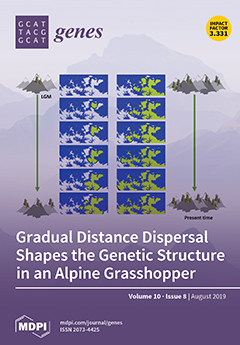The
SPP1,
LAP3, and
LCORL are located on chromosome 6 of sheep and a domain of 36.15-38.56 Mb, which plays an essential role in tissue and embryonic growth. In this study, we cloned the complete coding sequences of
SPP1 and partial coding regions of
LAP3 and
LCORL from Hu sheep (Gansu Province, China) and analyzed their genomic structures. The RT-qPCR showed that the three genes were expressed widely in the different tissues of Hu sheep. The
SPP1 expression was significantly higher in the kidney (
p < 0.01) and
LAP3 expression was significantly higher in the spleen, lung, kidney, and duodenum than in the other tissues (heart, liver, rumen, muscle, fat, and ovary;
p < 0.05). The
LCORL was preferentially expressed in the spleen, duodenum, and lung (
p < 0.05). In addition, the nucleotide substitution NM_001009224.1:c.132A>C was found in
SPP1; an association analysis showed that it was associated with birth weight and yearling weight (
p < 0.05), and NM_001009224.1:c.132C was the dominant allele. Two mutations XM_012179698.3:c.232C>G and XM_012179698.3:c.1154C>T were identified in
LAP3. The nucleotide substitution XM_012179698.3:c.232C>G was confirmed to be associated with birth weight, 1-month weight, 3-month weight (
p < 0.05), and 2-month weight (
p < 0.01). The nucleotide substitution XM_012179698.3:c.1154C>T was associated with birth weight (
p < 0.01), 1-month weight, and 2-month weight (
p < 0.05). The LAP3 gene XM_012179698.3:c.232C>G mutation with the C allele has higher body weight than other sheep, and CC genotype individuals show higher birth weight, 1-month weight, and weaning weight than the GG genotype individuals (
p < 0.05). Our results support the conclusion that the mutations on ovine
SPP1 and
LAP3 successfully track functional alleles that affect growth in sheep, and these genes could be used as candidate genes for improving the growth traits of sheep during breeding.
Full article






